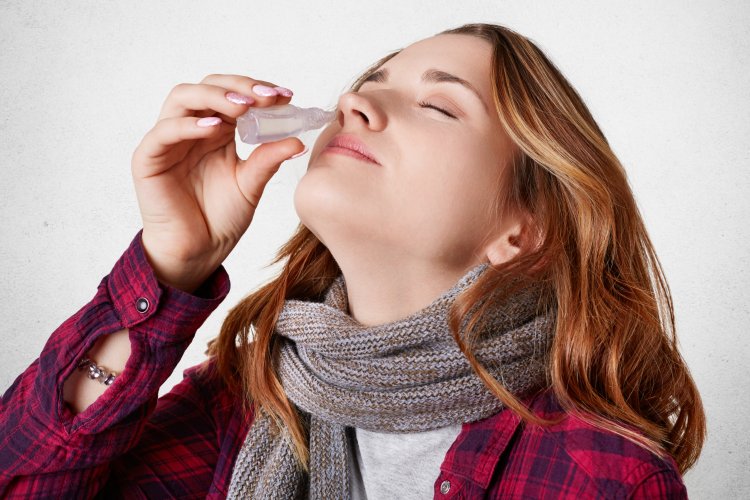How Does Post-Nasal Drip Develop?
Post-nasal drip develops when the glands in the nasal and throat regions produce an excessive amount of mucus. Under normal conditions, mucus plays an essential role in moisturizing and cleaning the nasal membranes, trapping and eliminating inhaled foreign particles, fighting infections, and humidifying the air. However, when there is an overproduction of mucus or a change in its consistency, it can accumulate and lead to the sensation of dripping down the throat.
Causes of Post-Nasal Drip
Several factors can lead to post-nasal drip, including:
Allergies: Allergic reactions to pollen, dust mites, pet dander, mold, and other allergens can trigger increased mucus production.
Infections: Viral infections like the common cold, influenza, and sinus infections can cause inflammation and increased mucus secretion.
Environmental Irritants: Exposure to smoke, pollution, strong odors, and chemicals can irritate the nasal passages, leading to increased mucus production.
Weather Changes: Cold or dry air can cause the mucus to thicken and become more noticeable.
Diet and Lifestyle: Certain foods, particularly spicy foods, and habits such as smoking can exacerbate mucus production.
Medical Conditions: Conditions such as gastroesophageal reflux disease (GERD), deviated septum, chronic sinusitis, and hormonal changes during pregnancy can contribute to increased mucus production.
Symptoms of Post-Nasal Drip
The symptoms of post-nasal drip can vary widely but often include:
- A constant sensation of mucus dripping down the back of the throat
- Frequent throat clearing
- Persistent coughing, which may worsen at night
- Sore throat
- Hoarseness or changes in the voice
- Bad breath (halitosis)
- Nasal congestion or a stuffy nose
- A sensation of a lump in the throat
- Difficulty swallowing
Diagnosis of Post-Nasal Drip
Diagnosing post-nasal drip typically involves a thorough medical history and physical examination by a healthcare provider. Key diagnostic steps include:
Medical History: The doctor will inquire about the patient's symptoms, duration, and any potential triggers or associated conditions.
Physical Examination: This includes examining the nose, throat, and ears. The doctor may look for signs of inflammation, mucus buildup, or other abnormalities.
Nasal Endoscopy: A thin, flexible tube with a camera (endoscope) may be inserted into the nasal passages to visualize the nasal and sinus cavities.
Allergy Testing: Skin tests or blood tests can help identify specific allergens that may be causing increased mucus production.
Imaging Studies: X-rays or CT scans of the sinuses can provide detailed images to help diagnose sinusitis or other structural issues.
Throat Cultures: If an infection is suspected, a throat culture may be taken to identify the causative agent, such as bacteria or fungi.
Treatment of Post-Nasal Drip
Treatment for post-nasal drip depends on the underlying cause and may include:
Medications:
- Antihistamines: These medications can help treat allergies and reduce mucus production.
- Decongestants: These help reduce nasal congestion and mucus production.
- Nasal Steroid Sprays: These are used to reduce inflammation and mucus production, especially in allergic conditions.
- Antibiotics: If a bacterial infection is diagnosed, antibiotics may be prescribed.
- Mucolytics: These medications help thin the mucus, making it easier to expel.
Lifestyle and Home Remedies:
- Hydration: Drinking plenty of fluids can help thin the mucus, making it less bothersome.
- Humidifiers: Using a humidifier can add moisture to the air and reduce mucus thickening.
- Saline Nasal Sprays or Rinses: These can help flush out excess mucus and allergens from the nasal passages.
- Avoiding Irritants: Reducing exposure to smoke, strong odors, and other irritants can help decrease mucus production.
- Elevating the Head: Sleeping with the head elevated can prevent mucus from pooling in the throat, reducing nighttime symptoms.
Surgical Intervention: In cases where an anatomical issue like a deviated septum is contributing to the problem, surgical correction may be necessary.
In conclusion, post-nasal drip is a common condition with a variety of causes, including allergies, infections, and environmental factors. Identifying and addressing the underlying cause is crucial for effective treatment. Most individuals can find relief from the symptoms through a combination of medications and lifestyle changes. Persistent or severe cases should be evaluated by a healthcare provider to determine the appropriate treatment plan.
Disclaimer:
The information provided in this article is for educational purposes only and should not be considered medical advice. If you have any health concerns or are experiencing symptoms, it is important to consult with a healthcare professional, such as a doctor or clinic, for proper diagnosis and treatment. Always seek the advice of your doctor or other qualified health provider with any questions you may have regarding a medical condition. Do not disregard professional medical advice or delay in seeking it because of something you have read in this article.
Hashtags:
#PostNasalDrip #HealthTips #MedicalAdvice #Allergies #ColdAndFlu #SinusInfection #HealthyLiving #MucusRelief






















